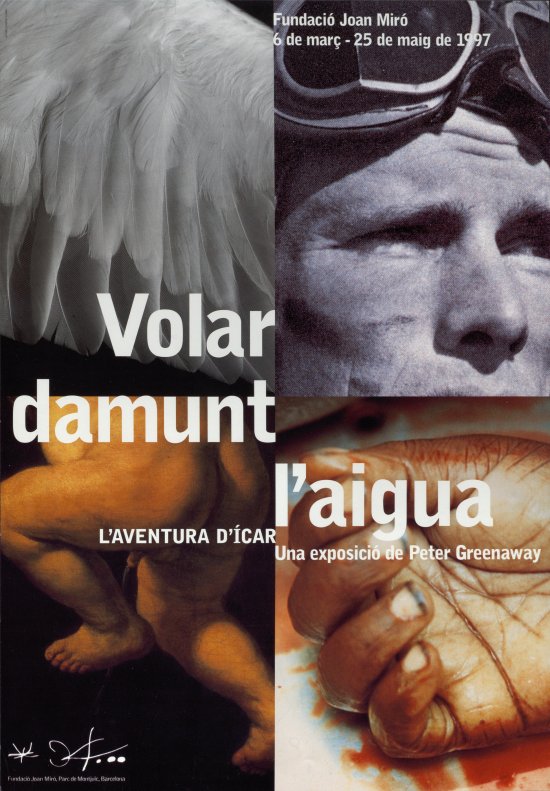- Dates
- —
Flying Over Water. The Adventure of Icarus. A Peter Greenaway Exhibition
Tired of his imprisonment on the island of Crete, Daedalus gathered enough feathers and wax to make four wings: two for himself and two for his son, Icarus. He warned his son not to fly too high – because the sun might scorch his feathers – or too low – because they might get wet from the sea and lose their lightness. Emboldened by the unexpected freedom of flight, Icarus failed to heed his father’s warning. He flew too high and the sun melted the wax that held the feathers on his wings, plunging him headlong into the Aegean Sea.
Icarus was the first man who managed to fly, but he was also the first to lose his life in flight. He represents the dream of individual flight, a dream that has been present in cultures throughout the ages. In it are written the hopes of Leonardo, the experiences of Montgolfier and his balloon, the successes of the Wright brothers, Blériot, Lindbergh, Amy Johnson and Gagarin. In it are represented all the misfortunes and disasters in the air, from the Viennese tailor Reichelt, who jumped from the top of the Eiffel Tower in a hand-stitched flying jacket, to the deaths of Glenn Miller and Buddy Holly in unexplained plane crashes. Flying is an ambition that signifies a brazen, extreme arrogance, a dream that will never be successfully realised. Neither aeroplanes, helicopters, hang-gliders nor space rockets will ever be self-sufficient: they all need machines to fly and are doomed to land sooner or later. What we want is personalised flight, with wings on our shoulders or ankles. Personal levitation. Superman aeronautics. To fly like a swallow, like an albatross or like a hummingbird, to free ourselves from gravity and be able to swim through the air. To fly between the walls of our house, to fly whenever we feel like it, on any sunny day, from Paris to New York, to rise personally to 10,000 metres and to plummet without risk to within a few centimetres of the sea. Impossible. It will not happen. It is the great dream that we know will never come true, but we never stop dreaming about it. It has long been present in cinematic fantasy. Fantomas, Tarzan, Superman, Flash Gordon, Batman. The trick in cinema is to film the flyer in a static position and make the world move behind him. But that is not enough.
In search of this impossible dream, the exhibition at the Fundació Joan Miró employs a generous retrospective perception to reflect ironically on the first myth of flight: the myth of Icarus. What kind of man was Icarus? Can we imagine him with a muscular, marathon-like physique, or with an anorexic body striving to be lighter than air? What kind of feathers did he use? What kind of water did he drown in? What was his final plunge into the Aegean like?
Using a vocabulary of text, light, sound, movement and staging borrowed from cinema, the English filmmaker Peter Greenaway has created an exhibition of thirty illustrations that continuously offer real candidates for the role of Icarus, interminable jets of water for his contemplation, Icarus’ coffin, navigational beacons, purifying baths, possible archaeological flights, wax, feathers, eggs and plunges. And in the optimistic belief that Icarus is still alive, a welcoming frame and runway have been prepared so that he can return to Earth in Barcelona between 6 March and 25 May 1997, three thousand years after he took off from the island of Crete in 1003 BC.


